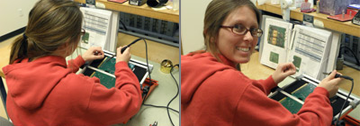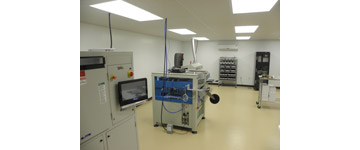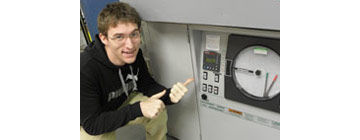
STC Employee Profile
It’s not just ISO certifications and customer-satisfaction metrics that tell the story of STC. Looking beyond those measurements, it’s the employees of STC that enable us to continue fulfilling customer expectations. This month, we are presenting a profile of one such employee, STC’s Courtney Webb.
Courtney first started working at STC in 2004, only to move to North Carolina nine months later. After two years in North Carolina, and the birth of her daughter, Courtney moved back to Illinois and returned to STC in the summer of 2006.
For her first four years at STC, Courtney worked primarily in the Transformer Production department, making literally hundreds of thousands of individual transformers. However, when asked how many different transformer models, Courtney stops talking about numbers and instead talks about customers and the products in which various models were used.
In 2009, Courtney started splitting time between transformer production and the electronics department, assembling through-hole components for STC’s printed-circuit-board products. In addition to circuit board assembly, Courtney also produces the cables and connectors used for PCB products. She now spends 90 percent of her time in electronics, where she’s continued to show her trademark attention to detail.
“We have very good work instructions, but there are other things to watch for when you’re working on electronics,” Courtney says. “A clean work environment is really important. It only takes a small bit of fuzz to interfere with a connection so we have to make sure everything’s clean.”
Outside of work, Courtney enjoys watching family ball games, shopping, and spending time at the lake (during the summer at least). What’s her favorite thing about working at STC?
“It’s a relaxed atmosphere. We’re careful to get things right, but things are still pretty relaxed.”

Common Concerns
During the past couple weeks, we have received a number of calls from prospective customers looking to make a change from their current transformer and electronic suppliers. These types of calls are not out of the ordinary.
What made these recent calls so interesting was the similarity in what people told us they were hoping to improve by sourcing products from STC. The number-one area of concern: Supplier Responsiveness.
Each caller was looking for a supplier that could offer quick turnaround of prototypes, the ability to make design changes—and ship updated designs—quickly, and the ability to answer questions without having to forward the questions on to an overseas manufacturer, and then wait for the answer.
Another common question is whether our products are made in the USA, and beyond that, whether any of our products are outsourced. Customers may be required to meet federal requirement, or may simply wish to avoid the hassle of overseas orders.
There are other concerns of course, such as quality of product, component lead times, and price. However, these matters are often addressed, at least in part, by overall responsiveness.
“Our turnaround time for prototypes and design changes is usually much better than the standard six to eight-week turnaround time for most other manufacturers,” says Design Engineer Les Vaughn. “Customers appreciate being able to call or email when they need an answer to a specific question about a part, to get the answer quickly—and to have confidence in the answer.”
Another common question is whether our products are made in the USA, and beyond that, whether any of our products are outsourced. Customers may be required to meet federal requirement, or may simply wish to avoid the hassle of overseas orders.
“One-hundred percent of our products are made in the USA,” says Vaughn. “Overseas orders typically require large shipment amounts, and then you have the long lead times for the shipment. Customers of STC just don’t have to concern themselves with those things.”
Vaughn continues, “Customers of STC also know that we’re ISO 9001 certified and have been for many years. So providing quality products, quick answers, and being responsive otherwise is just a part of what we do.”
Fullfilling Orders of All Types
In recent years, there has been a renewed focus on American-made products as well as products with higher amounts of American-made parts. This trend is part of a greater initiative to increase U.S. manufacturing, which is often referred to as re-shoring.
As this focus on US products continues to increase, STC has received an array of order types, from orders for 200,000-plus low-profile printed-circuit components to orders for just a few large 10-KVA three-phase power-supply components.
The ability to quickly transition between these diverse types of orders—while still producing quality components—has been an important strength for STC.
There are a number of attributes that enable STC to deliver on our promise of timeliness and quality. A few of these attributes include:
Production Staff: First and foremost, a capable and well-trained production staff is absolutely essential. Additionally, the ISO procedures used by STC provide the framework so our staff is able to build products that meet our strict quality requirements.
Equipment: The equipment used to manufacture smaller printed-circuit components is quite different than the equipment used for large three-phase transformers. STC has the necessary machinery to build components large, small, and everything in between.
Test Procedures: As with production, rigorous testing requires proficient staff and reliable test equipment. However, it also requires close attention to how tests are carried out. STC follows ISO test procedures for all shipped products.
STC Adds 8,000 Square Feet
STC, Incorporated announced today that it will be expanding its McLeansboro, Illinois facility. The industry-leading designer and manufacturer of printed circuit assemblies, transformers, and electronics products has purchased an 8,000 square foot structure and is in the process of renovating work space and upgrading communications capability within the building.
The additional space will be used primarily as office space for the Systems and Software group, which is responsible for hardware layout and design, software development and testing, and firmware development and testing.

Surface-Mount Equipment Added to Lineup
STC Electronics recently installed equipment for a new circuit-assembly line, enabling the company to better meet the continuing transition to surface-mount printed circuit boards. The line is housed in a new room with positive-pressure hepa air filtering.
The mid-volume assembly equipment includes a stencil printer, pick-and-place machine, lead-free reflow oven, and low-discharge deflux system.
Due to the size and weight advantages, Surface-Mount Technology (SMT) has become the preferred method for assembling small PCBs with high connection density. Not surprisingly, the demand for surface-mount assembly has increased in proportion to the number of small devices in electronics markets. In fact, about 90 percent of new PCB assemblies manufactured by STC Electronics are made using surface-mount placement. The new equipment allows STC to more effectively manufacture these types of small components.

STC Electronics Celebrates 25 Years
STC is celebrating their 25th anniversary as a manufacturer of high-performance transformers and electronics. As an ISO 9001 certified business, STC designs and manufactures printed circuit assemblies, custom cable assemblies, and wire harnesses.
The roots of the STC story trace back to 1967, to a company in Cape Girardeau, Missouri by the name of National Transformer. In 1986, current STC president Brad Cross was part of a group that acquired the engineering files and select assets from National Transformer. Cross moved the manufacturing facility to McLeansboro, Illinois in 1988.
The early weeks and months after the move to Illinois were filled with trials and obstacles to overcome, as production was temporarily conducted at both facilities. Production Supervisor Linda Shaw, who has been with STC since it’s beginning in McLeansboro, remembers these trials well.
“During the first week, we had no test equipment so we carefully built parts, shipped them out, and hoped they worked. We had only four or five winders, and no packing equipment or solder machines. But when we got our test equipment that second week, we did 100-percent testing just like we do today.”
The small cinder block building that housed STC during the first five years presented its own set of challenges.
“During a snowstorm that first winter, while we were assembling components, we started hearing an occasional “Pssst” sound,” Shaw recalls. We looked around, wondering what the sound was, and we saw little bits of snow blowing into the building. We were hearing the sound of snow landing in the hot solder pots.”
Shaw credits company president Brad Cross for the improved working conditions.
“He’s made it safer. He’s made it much easier and more efficient. We’ve come a long way.”
When asked about the STC’s advantages in the industry, Cross points to specific examples.
“We have low turnover for one thing,” Cross says. “Our staff is very experienced, but they’re also willing to learn the new technologies that we implement in order to increase efficiency.”
The figures bear this out. In fact, approximately 30 percent of the workforce has been with the company for over 15 years. Staff members take pride in being familiar with customer requirements and their intended use of STC products.
The production equipment today scarcely resembles the equipment in place 20 years ago, and Cross says that is another important factor in remaining a competitive industry leader.
“We focus on embracing change while remaining strong in what we do well,” Cross says. “Whether it’s getting a fax machine like we did in the early years when they weren’t widely used or installing SMT-assembly equipment. The quality environment we’ve established ensures that we’ll continue to provide reliable products, and it also enables us to look toward continually improving efficiency.
STC’s Green Initiatives
Shortly after STC opened its doors in 1986, the company started recycling the various bits of scrap left over from production jobs. From a conservation perspective, it just made sense not to add recyclable and reusable items to the landfills. From a financial perspective, the company realized a modest return by sending in scrap for recycling.
Through the years at STC, the number of items sent back for recycling and re-use has steadily increased, while the percentage of material sent to landfills has decreased.
So what prompted this trend in the first place?
“Spools,” says STC employee Les Vaughn. “Early on, we realized how many of our empty plastic wire spools were ending up in the landfill, so we got together and talked about what we could do about it. We spoke to our suppliers and came up with an agreement to send the spools back for re-use.”
“From there, we started recycling iron, solder dross, and wire,” Les adds. “And now, of course, we also recycle paper, cardboard, plastic, and aluminum cans.”
“Early on, we realized how many of our empty plastic wire spools were ending up in the landfill, so we got together and talked about what we could do about it. We spoke to our suppliers and came up with an agreement to send the spools back for re-use.”
In recent years, it’s become easier to find ways to conserve materials and energy. In fact, STC replaced all water fixtures with ultra-efficient models last year. Appliances and lights have also been replaced, as needed, with Energy Star models.
STC has addressed the less obvious areas of waste as well.
“There are other areas where we’ve made an effort to reduce waste,” says company President Brad Cross. “For example, we were able to get one multi-function machine to handle the job of one printer, two faxes, and a scanner.”
“We’re also vigilant about making sure our manufacturing equipment is up-to-date and works properly so we don’t end up with large amounts of scrap as it is,” says Cross.
Cross says the long-term goal is to eventually get the plant building Energy Star qualified.
“These types of building use an average of 35-percent less energy than typical buildings, so the advantage is clear.”
New Equipment Added to Lineup
STC, Inc. recently added two new components to it’s array of production equipment, increasing product versatility and decreasing production time for PC-mount transformers and mid-size toroids.
The new laminator, an HBR Industries product, is used to manufacture one of STC, Incorporated’s benchmark products.
“The products we make most often with the new laminator are the low-profile transformers that are mounted on printed-circuit assemblies,” says Vice President of Operations Angie Calkin.
These parts are most commonly used in electronics applications where vertical space is very limited but a relatively sizable output voltage is still required. Refer to the LPC Transformer page on the Sun Transformer site for more information about these types of transformers.
“The biggest advantages that come from having this laminator are the versitility it offers and the quick turnaround time in production,” says Calkin. “Our low scrap level from using this laminator has also been very impressive.”
The other new piece of equipment, a mid-size Gorman Productor II toroid winder, also benefits electronics applications with limited space.
As with the new laminator, the new winder allows STC to build a wide variety of toroids. It also enables building products that are not feasible to be built by hand.
“Some toroids require several hundred turns of wire, which is very challenging to do by hand,” says Design Engineer Les Vaughn. “Others require very small-diameter wire, and this winder can handle those types of jobs.”
“These kinds of toroids are used for a lot of circuit board assemblies, especially the very small boards that require miniaturized components, so the benefits of having this new winder are many.”

The Secret Life of an STC Intern
Nick Freed wrapped up his spring semester at St. Louis University last May. At that point, he had to decide how to spend his summer before returning to school in the Fall.
The options for a young college student are many. Two months backpacking through Europe? Studying abroad at the University of Pimpleton? Sitting at home in pajamas eating pizza and playing video games?
Nick knew a summer internship would be the most beneficial option in the long run. As an aerospace engineering student, he also knew applying one of the many associated engineering fields would help as well. So when he saw the ad for an engineering position at STC, Nick felt his stomach tighten and his spirits swell. After throwing away the pizza boxes and taking some antacid, Nick contacted STC.
To Nick, aerospace engineering is the perfect combination of all the engineering fields that pique his interest. It encompasses everything from fluid dynamics (an aircraft’s movement through air) to chemical engineering (materials used to fuel a rocket). But would an internship at STC provide experience in any of the associated engineering fields?
In short, yes it would.
Take, for example, the simple task of getting a cup of coffee for a senior staff member (me). This task incorporates Fluid Dynamics (“Nick, get me some coffee!”), Thermodynamics (“Make sure it’s hot, but not too hot.”), Materials Engineering, (“Oh, and put it in my favorite mug.”), Chemical Engineering (“Remember to use the pink sweetener.”), and even Physics (“Whoops, I spilled it in your lap, boss.”). I can’t be sure, but that last remark seemed just a bit sarcastic.
“The QA testing was beneficial because I was sort of the company’s promise to the customer that our products would work as advertised.”
In truth, Nick (a.k.a. “Nick the Intern”) hasn’t retrieved so much as one cup of coffee for anyone at the plant. However, he has been very helpful with some important projects. He was our turn-to guy when we purchased a new Watlow F4D Controller, which is used to run test profiles for our environmental chamber. He performed numerous quality assurance tests and helped write procedures for these tests.
As crazy as it sounds, Nick says those QA tests may have been the most enjoyable part of his time at STC.
“The QA testing was beneficial because I was sort of the company’s promise to the customer that our products would work as advertised.”
Nick recently returned to work at STC during his Christmas break, and will be leaving us again soon. The Watlow controller is still running environmental tests and the QA tests are still being conducted as designed. Thanks Nick, and best of luck!

STC Recertified to ISO 9001:2008
During November of every year, we here at STC start feeling a little festive. An excitement fills the air, and workers throughout the plant await the arrival of a special visitor.
Yes, that’s right. It’s time for a visit from our independent auditor to verify that our quality processes continue to meet ISO standards.
Since 1999, STC has been certified every three years to ISO standards. Each May and November we welcome our auditor back for a surveillance visit to ensure that the various aspects of our manufacturing process are being performed properly. This year marks the second straight year that we’ve met the updated ISO 9001:2008 standard.
I recently visited with Angie Calkin, who serves as Vice President of Operations, to ask her about the importance of meeting ISO standards.
Q: STC, Inc. has met ISO 9001 standards since 1999 and has been recertified every three years since then. Why is this done?
A: We have some customers who either require it or would want to do their own process audits at the plant if we weren’t certified. But it’s more than that. We have other customers who don’t require that we meet ISO standards but still benefit because we do.
Q: How so?
A: When we implemented our quality system, we saw a steady decrease in both customer concerns and customer returns, and that applied to all of our customers because the same process is followed for every product and in every phase of manufacturing.
“Before we start full production on an order, we test two or three units to make sure they meet exact customer specifications. After a unit passes pre-testing, we can produce the full order. That way, we don’t complete production on an order then find out we missed a slight detail.”
Q: Have the quality processes helped make STC more efficient?
A: The ISO standards are intended to improve overall quality rather than reducing manufacturing time, but we do spend less time correcting production errors so we can factor in that aspect of it.
Q: Are there other benefits?
A: In cases where we submit our products for consideration on large projects, the customer will have a list of standards we must meet before we can be considered. For the most part, we can show the customer that we already meet their requirements—and have for many years—because their requirements are already part of our ISO quality processes.
Next, I spoke with Brad Cross, president of STC, Inc., to get his thoughts on the whole quality process.
Q: Having recently completed another ISO recertification, what are your thoughts about the importance of this event?
A: The first thing that comes to mind is that it’s a real tribute to the diligent work of our Quality Manager Angie Calkin and the rest of the staff who have taken our quality processes very seriously. They’ve recognized the importance of our quality procedures and the resulting benefits to our customers.
Q: What types of customer benefits have you noticed?
A: One big improvement that we made while implementing this process was pre-testing. Before we start full production on an order, we test two or three units to make sure they meet exact customer specifications. After a unit passes pre-testing, we can produce the full order. That way, we don’t complete production on an order then find out we missed a slight detail.
Q: Is this testing done for both electrical and mechanical specs?
A: Yes. Of course, we also perform 100 percent testing on all of our parts after production is complete—and pre-testing really helps decrease the number of errors we find at that point. A huge part of our quality improvement is the longevity and experience of our staff. If you’ve got people like Randy Kaufman [Senior Test Technician at STC], who knows exactly what to expect with each part, they’re going to recognize when something isn’t quite right, and they make sure the issue is corrected before we ship them out.

